87 F. high in the Twin Cities Thursday.
80 F. average high on August 22.
79 F. high on August 22, 2012.
T-storms possible Saturday morning.
90s likely Sunday into much of next week.
Over 10% of Minnesota in moderate drought again. Details below.

The 4th of Labor Day
My dusty, faded Snap On Tools Calendar on the
wall insists that it's late August - Labor Day coming up. Then why do
the maps for next week look like the 4th of July? Historically the
hottest days of summer come 3-4 weeks after the Summer Solstice - the
heat usually peaks mid or late July. Not this year.
I'm watching model trends and continuity
(consistency from run to run) carefully, and it now appears next week
may wind up being the hottest week of summer for much of Minnesota,
coming on the cusp of meteorological autumn.
I'd like to say I'm surprised, but I'm getting
to the point where nothing shocks me anymore. A blizzard in southeastern
Minnesota in May? Frost in Embarras in mid-August? Bring it on.
Enjoy one last day of relative comfort: dew
points in the 50s under blue sky. The approach of a steamy hot front may
set off T-storms Saturday morning (yes, we need the rain). By Sunday
highs surge into the 90s, ECMWF guidance hinting at a few mid to upper
90s next week.
Under this nearly stationary heat dome any
storms will be isolated - the air too hot & dry for significant
convection. Slight relief is possible late next week but the Dog Days of
September may spill over into Labor Day.
What a summer huh?
Hottest Week of Summer? The heat (and humidity) next
week may rival or even surpass the heat we experienced in early July,
perhaps 5-6 days of 90+ highs with dew points reaching the low 70s by
Sunday, maybe mid 70s by Wednesday. I suspect we'll see a few mid-90s,
maybe as early as Sunday. Chart:
weatherspark.com.
Sunday Heat Spike? After reaching upper 80s Saturday
(morning clouds and T-storms keeping us a few degrees cooler than we
would be otherwise) we break out into a sunny airmass on the hot side of
the front Sunday. Models are already hinting at mid 90s, and some upper
90s can't be ruled out, especially south/west of the Twin Cities.
Graph: Iowa State.
Advancing Hot Front. The 84 hour NAM model (NOAA)
shows comfortable high pressure over New England into the weekend, but a
bulging ridge of high pressure pushes intense heat across the Plains
into the Midwest, boosting the mercury well into the 90s by Sunday. Cabo
San Lucas may see heavy rain from a developing tropical storm off the
coast of Baja Mexico.
Uh Oh. This is starting to feel a little like last
summer: starting (very) wet, then going over a rainfall cliff by August.
According to the
Drought Monitor
Minnesota has gone from 1.7% moderate drought to 10.11% moderate
drought as of August 20. Most of the state is now designated as
"abnormally dry". Remind me not to complain about a few random T-storms
Saturday morning, because rainfall next week will be spotty and sparse.
Could A Hurricane Ever Strike Southern California? The
answer is yes, although the risk is very low due to upwelling of chilly
Pacific Ocean water. Generally water temperatures need to be 80-81 F.
for hurricane development. As anyone who has ever taken a dip in the
Pacific will confirm, water temperatures are usually in the 50s, maybe
low 60s off the coast of L.A. and San Diego. During an extreme El Nino
it's conceivable that water could remain (just) warm enough to support a
hurricane pushing into southern California. Here's an excerpt of a post
from
NASA: "
There's
an old adage (with several variations) that California has four
seasons: earthquake, fire, flood and drought. While Californians happily
cede the title of Hurricane Capital of America to U.S. East and Gulf
coasters, every once in a while, Mother Nature sends a reminder to
Southern Californians that they are not completely immune to the whims
of tropical cyclones. Typically, this takes the form of rainfall from
the remnants of a tropical cyclone in the eastern Pacific, as happened
recently when the remnants of Hurricane John brought rain and
thunderstorms to parts of Southern California. But could a hurricane
ever make landfall in Southern California? The answer, as it turns out,
is yes, and no. While there has never been a documented case of a
hurricane making landfall in California, the Golden State has had its
share of run-ins and close calls with tropical cyclones. In fact,
California has been affected by at least a few tropical cyclones in
every decade since 1900. Over that timeframe, three of those storms
brought gale-force winds to California: an unnamed California tropical
storm in 1939, Kathleen in 1976 and Nora in 1997. But the primary
threat from California tropical cyclones isn't winds or storm surge.
It's rainfall -- sometimes torrential -- which has led to flooding,
damage and, occasionally, casualties..."
Image credit above: "
In
September 1997, powerful Hurricane Linda, shown in this NASA rendering
created with data from the NOAA GOES-9 satellite, was briefly forecast
to strike Southern California, most likely as a tropical storm, as
shown in the inset forecast track from the Naval Research Laboratory’s
Marine Meteorology Division. The storm eventually turned westward away
from land, but still brought rainfall to parts of Southern California
and high surf." Main image credit: NASA/NOAA. Inset image credit: NRL/NCEP. › Larger view
California Hurricane? Highly Unlikely, But Not Impossible. In fact it almost happened in 1997 with Hurricane Linda. Today's
Climate Matters
looks at why the West Coast doesn't see hurricanes (as a rule) and how
an expanding heat bubble over the USA may ultimately increase the
potential for Atlantic hurricanes by September: "
WeatherNationTV
Chief Meteorologist Paul Douglas goes over some late season hurricane
climatology. Also, what are the chance that a tropical storm hits
California? How does the heat bubble baking the Central Plains and
Midwest play into late season tropical storms?"
2013 Hurricane Season A Bust? Not So Fast. It's a
little premature for complacency for anyone living in or near Hurricane
Alley. Here's a clip from a story and video at
floridatoday.com: "
Almost
halfway finished, the 2013 hurricane season has been a breeze in
Florida. But Craig Fugate, the federal government's top emergency
manager, looks at things a little differently. His question: "Have we
started playing college football yet?" Fugate and Bryan Koon, director
of the state Division of Emergency Management, held a news conference
Wednesday to reinforce the message that Florida is just entering the
thick of hurricane season in late August and September --- which,
coincidentally is when college football starts."
Graphic credit above: "
Does Brevard have "Hurricane
Amnesia?" : The last time Brevard County (Florida) endured hurricane
force sustained winds was 1979 with Hurricane David. Are Brevard
residents prepared for the 2013 hurricane season? The is an excerpt from
the "Matt Reed Show". Posted June 26, 2013."
Atlantic Basin Primed For An Above-Normal Hurricane Season.
Yes, it's very quiet out there - and we have yet to see our first
hurricane of the season in the Atlantic. Based on a variety of factors
(less Saharan dust, warmer water temperatures, low wind shear) I
suspect September will be a lot busier than August has been. More
details from NOAA's
Climate.gov: "
Andrea, Barry, Chantal, Dorian, Erin*... who’s next? Probably plenty more, according to NOAA’s updated Atlantic hurricane season outlook.
With five named storms already in the books this summer, the 2013
hurricane season is shaping up to be above normal, and there is a
possibility that it could be very active during the peak of the season
from mid-August through October. An additional 9-15 named storms are
likely, of which 6-9 are predicted to become hurricanes, with 3-5
reaching major hurricane status. Among the climate factors behind the
heightened activity? Heat. These maps show the tropical cyclone heat
potential of the tropical Atlantic Ocean ramping up between May 24
(bottom) and August 4 (top). This “hurricane heat potential” depends
not just on the surface temperature, but on the depth of the warm water..."
National Hurricane Center Gives Storm Surge Modeling A Major Boost. Here's a clip from an interesting story at The Washington Post's
Capital Weather Gang: "
The
National Hurricane Center (NHC) is running an improved version of
its old, reliable storm surge model on faster computers to help
emergency managers update hurricane evacuation plans. When a storm
threatens any place in the U.S. NHC forecasters will use the improved,
faster-running model to predict its surge. Hurricane forecasters know
those who might be in a hurricane’s path tend to focus on the
storm’s wind speed, which define its one-to-five category. “The
categories put a focus on wind; people are absorbed by wind,” says
Jamie Rhome, the NHC’s storm surge lead, but “water is what kills the
vast majority of people. Evacuations are done for surge...”
Photo credit above: "
Storm surge from Hurricane Dennis in 2005." (USGS)
July: 341st Month/Row Of Warmer Than Average Global Temperatures. Meteorologist Andrew Freedman has the story at
Climate Central; here's a clip: "
The
year-to-date has been the sixth warmest on record globally, and July
was also the sixth warmest such month since global surface
temperature records first began in 1880, according to new data
released on Tuesday by the National Oceanic and Atmospheric
Administration (NOAA). The figures show that July 2013 was the 37th
straight July, and the 341st straight month, with warmer-than-average
global temperatures — a more than 28-year timespan that reflects the
significant warming observed worldwide since the 1970s. That means
that no one under the age of 28 has ever experienced a month in which
global average surface temperatures were cooler than average (based
on the 20th century average)..."
Apple, Closer To Its Vision For A TV Set, Wants ESPN, HBO and Viacom, and Others To Come Along. Will Apple ever come out with a TV? Timing (and content deals) are everything. Here's a clip from a good story at
Quartz: "
Years
of halting negotiations with cable companies haven’t gotten Apple much
closer to its grand vision for television. But a newer strategy of
talking directly to content providers seems more promising. Apple
is negotiating with production studios and networks to provide content
for a television set that would emphasize apps over cable TV,
according to people familiar with those discussions. Among the
companies that have talked to Apple are Disney’s ESPN, Time Warner’s
HBO, and Viacom, which owns MTV Networks, Nickelodeon, and Comedy
Central. It’s unclear how close these
deals are to fruition. Some people cautioned that, with the TV industry
in such flux, “everybody is talking with everybody.” Any deal with an
internet TV service like the one envisioned by Apple is likely to be
under similar terms as the networks have negotiated with traditional
cable companies..."
Photo credit above: "
Still waiting". Reuters/Aly Song
Hollywood And Steroids: When A-List Actors Go The A-Rod Route.
I'm just waiting for a story to come out about steroid use in the
meteorological industry. I have some questions about Al Roker. In the
meantime here's an excerpt from a fascinating read at
The Hollywood Reporter: "
In
2005, a 30-something actor on the precipice of superstardom began
prepping for a lead feature role that required ample spotlight on his
abs. The actor met with the film's trainer and outlined the
performance-enhancing drugs, including human growth hormone (HGH), he
already had been taking. The trainer, a firm believer that a chiseled
physique should be achieved naturally, recused himself from working with
the actor. "He told me that HGH made him feel like nothing else ever
made him feel," recalls the trainer, who declined to be identified out
of respect for trainer/trainee confidentiality. "He was basically
addicted. I told him to find another trainer. He did..."
Image credit: Illustration by Licoln Agnew.
 Bismarck Is Lovely This Time Of Year
Bismarck Is Lovely This Time Of Year. Really. The
thrust of this story (which makes a lot of sense to me) is: people need
to MOVE to where the jobs are! Easier said than done, with kids in
school and care for parents, not to mention moving away from friends.
Here's a clip from a story at
Slate: "...
Of
course there are always good reasons not to move. Midland, Texas (3.7
percent) is remote. Minneapolis (5.1 percent) is cold. Honolulu (4.7
percent) is expensive. Morgantown, W.V. (4.5 percent) is small. And
Bismarck, N.D.—America’s unemployment rate champion, at just 2.8
percent—managed to be remote, cold, expensive, and small all at once.
Meanwhile, areas with even the most hopeless economies might offer good
cause to stay. People may have relatives to look after in their
hometown, or else depend on relatives to take care of their kids. People
have friends and family. They have financial and personal commitments.
Moving is expensive, and moving to a new pace where you don’t have a
job lined up is scary. Ask any given person in any given town why they
don’t move to some other town, and the list of reasons will be endless..."
* PS:
this is the most terrifying file photo on my laptop. Look closely:
she's on her cell phone reading a book in bumper to bumper traffic. Where's a cop when you need one?
What Your Ikea Chair Says About You. I found this vaguely interesting - here's a clip from
priceonomics.com: "...
This means that our surrounding environments may strongly influence our feelings and behaviours. A forthcoming paper
from researchers at MIT, Columbia, Northwestern, Harvard, and Berkeley
investigates whether something as simple as the size of our chair or
workspace can nudge us toward dishonesty. The study, entitled “The
Ergonomics of Dishonesty: The Effect of Incidental Posture on Stealing,
Cheating, and Traffic Violations,” begins by citing academic research
on the link between posture and thoughts, feelings, and social status.
In a terrifyingly offhand manner, they also cite research showing that
power “appears to be linked to increases in a wide
range of dishonest behaviors.” The theoretical ground for their idea
established, they ask whether manipulating the physical environment can
induce people to act less honestly..."
7 Life Secrets Of Centenarians. Want to live to be 100 years old? Let me think about that. Here's an excerpt of an interesting story at PBS's
Next Avenue: "...
To
be sure, these centenarians are among the best, brightest and
healthiest of the current class; that's what makes them role models for
the future of aging. Here are seven secrets they cite for living a long
and happy life.
1. A Positive Attitude Trudi Fletcher of Tubac,
Ariz., a lifelong artist, remains an innovative painter at 100 and
recently had a gallery exhibition showing off her new style. She
credits her creative longevity to "attitude, attitude, attitude."
Almost all of the centenarians we spoke to \believe a positive yet
realistic attitude is critical throughout one's life and described
themselves as optimistic people.
2. Diet Here's diet advice you may not have heard before: Eat like it's 1960. Our centenarians were critical of today's supersized portions;
the majority advised just eating nutritious food in moderation. Only
20 percent said they had ever been on a specialized diet plan, although
some had become vegetarians. Lillian Cox, 107, of Tallahassee, Fla.,
confided that in her 50s she became "quite heavy" but resolved to lose
the weight, did so and kept it off by just eating less. The stylish
former dress shop owner says, "I was a good advertisement for the
merchandise I selected on my frequent buying trips to New York..."
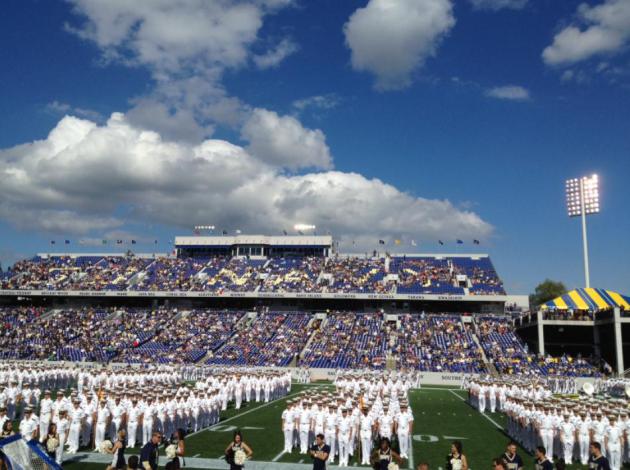 How Far Do You Run Playing Different Sports
How Far Do You Run Playing Different Sports. By
Gizmodo's calculations,
during a typical pro basketball game, about 2.72 miles, compared with
1.25 miles for an average NFL football game (11 whole minutes of
action!) Here's an excerpt of the story: "
While watching sports,
have you ever stopped (midway through a bowl of Cheetos) to wonder,
"How far are those guys actually running?" It's a common question, one
that's historically been subject mostly to guesswork, Thanks to some
recent technological developments, though, we can now actually apply
some data to it. So which of your heroes are putting in the hard yards? Welcome to Fitmodo,
Gizmodo's gym for your brain and backbone. Don't suffer through life
as a sniveling, sickly weakling—brace up, man, get the blood pumping!
Check back on Wednesdays for the latest in fitness science, workout
gear, exercise techniques, and enough vim and vigor to whip you into
shape..."
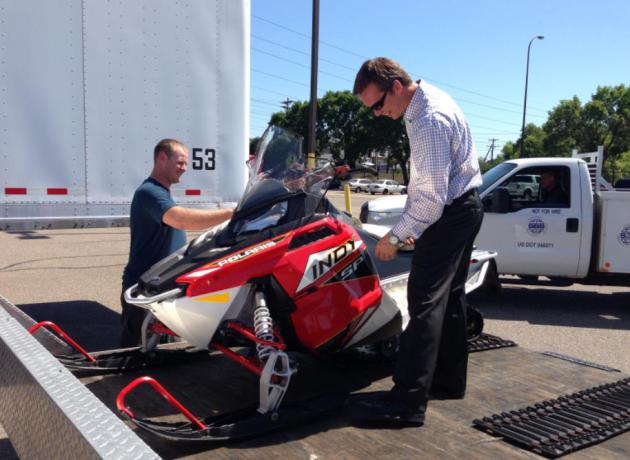 You Know Something I Don't?
You Know Something I Don't? That's my friend and business partner, Todd Frostad, loading up a new sled for
Hay Days in North Branch on September 7. A good winter for snowmobiling? Place your bets.

TODAY: Warm sunshine. Dew point: 55. SE 10. High: 86
FRIDAY NIGHT: Pleasant evening, clouds increase - thunder possible late. Low: 67
SATURDAY: AM T-storms. Sticky PM sun. Dew point: 66. High: 88
SUNDAY: Hot sun. Dew point: 70. Feels like 100F by mid afternoon. Wake-up: 74. HIgh: 94
MONDAY: Sunny, still tropical. Heat alert? Wake-up: 75. High: 93
TUESDAY: Dog Days came late. Hot sun. Wake-up: 75. High: 95
WEDNESDAY: Intervals of sun, muggy. Dew point: 71. Wake-up: 76. High: 93
THURSDAY: Still blazing. Get to lake early. Wake-up: 75. High: 96
Climate Stories...
Rising Seas. This is the cover story for September's
National Geographic; here's a snippet of the online version, courtesy of NatGeo: "...
Global
warming affects sea level in two ways. About a third of its current
rise comes from thermal expansion—from the fact that water grows in
volume as it warms. The rest comes from the melting of ice on land. So
far it’s been mostly mountain glaciers, but the big concern for the
future is the giant ice sheets in Greenland and Antarctica. Six years
ago the Intergovernmental Panel on Climate Change (IPCC) issued a report
predicting a maximum of 23 inches of sea-level rise by the end of this
century. But that report intentionally omitted the possibility that
the ice sheets might flow more rapidly into the sea, on the grounds
that the physics of that process was poorly understood. As the IPCC
prepares to issue a new report this fall, in which the sea-level
forecast is expected to be slightly higher, gaps in ice-sheet science
remain. But climate scientists now estimate that Greenland and
Antarctica combined have lost on average about 50 cubic miles of ice
each year since 1992—roughly 200 billion metric tons of ice annually.
Many think sea level will be at least three feet higher than today by
2100. Even that figure might be too low..."
Bloomberg: Why Sandy Forced Cities To Take Lead On Climate Change.
Solutions will be slow in coming from our "do as little as
possible" Congress. Many of the innovations, the attempts to harden
infrastructure and make cities more resilient, will come at a state and
local level. Here's a portion of an Op-Ed from New York City Mayor
Michael Bloomberg at
CNN: "...
Last
fall, Hurricane Sandy made all too clear how vitally important it is
to build stronger and more sustainable infrastructure that can
withstand extreme weather events. That's why in June, we launched a long-term plan
specifically focused on protecting our city from the effects of climate
change. For instance, we're working to strengthen dune systems and
beaches across the city. Our plan includes surge barriers to prevent
flooding and a strong network of bulkheads, floodwalls, levies, and
other protections in vulnerable places along the waterfront. We are
working with private companies and regulators to strengthen critical
infrastructure against severe weather -- including our power,
telecommunications, and transportation systems. And we're also raising
construction standards to ensure new buildings can withstand extreme
weather..." (Photo: AP, New Jersey Air Force)
Hurricane Enable: How Climate Change Is Mixing Up Bigger, Badder Storms. Atlantic hurricanes are becoming more extreme over time, a nearly doubling of intense, Category 3+ storms since the 1970s.
Grist examines the trends; here's a clip: "...
Not
only does the heat provide more fuel for devastating hurricanes, like
turning up the heat on the pressure cooker, but warmer air above the
hotter oceans also holds more water vapor.
“That affects all storms: It leads to heavier rainfalls,” Trenberth
says. And the effect is not linear. It scales up, making the most
powerful storms far stronger. That 1 degree C rise in temperature has
led to about 5 percent more water vapor over the Atlantic, but the
storms don’t just get 5 percent stronger, Trenberth says. The water
vapor “gives the storm extra buoyancy, so you could argue you get as
much as a 10 percent increase in the power of the storm.” He estimates
that the the real number is probably somewhere in between 5 and 10
percent. These more powerful storms are also riding higher oceans. Globally, sea level has already risen to the tune of eight inches since 1870. In many places, the rise is even greater. Higher baseline sea levels give storm surges a running start..." (Image above: NASA).
Is Climate Change Humanity's Greatest-Ever Risk Management Failure? Short answer. Probably. Here's the intro to a post at
The Guardian: "
Humans
are generally very risk-averse. We buy insurance to protect our
investments in homes and cars. For those of us who don't have
universal health care, most purchase health insurance. We don't like
taking the chance - however remote - that we could be left unprepared in
the event that something bad happens to our homes, cars, or health. Climate change
seems to be a major exception to this rule. Managing the risks posed
by climate change is not a high priority for the public as a whole,
despite the fact that a climate catastrophe this century is a very real
possibility, and that such an event would have adverse impacts on all
of us. For example, in my job as an environmental risk assessor, if a
contaminated site poses a cancer risk to humans of more than
1-in-10,000 to 1-in-1 million, that added risk is deemed unacceptably
high and must be reduced..."
Photo credit above: "
Our gamble may lead to an unstable future climate." Photograph: Don Mcphee
A Cosmic Correlation Between Northern Lights And Global Warming? A
minimum in the natural solar cycle (and sunspots) might shave global
temperatures by a fraction of a degree C, probably not enough to make a
dent in gradually warming temperatures worldwide. Here's a clip from an
interesting story at
Alaska Dispatch: "
What
would happen to global warming if the sun quit producing sunspots for a
few decades? The question is of more than passing interest to climate
scientists as they ponder the prospect that the sun may be about to
enter such a period. The coming flip of the sun's magnetic field in a
few months marks the peak of the current sunspot cycle – one that has
produced the fewest sunspots in at least 100 years, and perhaps the
last 200 years. Peering at trends – or in some cases, the lack of them –
in the sun's behavior during the run-up to the current cycle's peak,
some solar physicists increasingly are considering the possibility that
the sun may be on the verge of a "grand solar minimum," comparable to a
70-year period running from the early 17th century into the early 18th
century, when the sun produced no sunspots at all..."
Climate Change: Speaking The Unspeakable.
Psychologists tell us that most people refuse to accept a problem for
which there is no obvious solution. That's one of the many challenges
with climate change: no silver bullet. But there is a boxful of silver
buckshot - thousands of improvements, tweaks and innovations, which in
the aggregate, scaled worldwide, can make a difference.
The Energy Collective has the story; here's a clip: "
Rosemary Randall, a writer I’ve just encountered for the first time, has a very worthwhile piece up at Aeon Magazine, The id and the eco:
In dealing with climate change, we are in the terrain that
psychoanalysis calls resistance or defence — the ability to defend
ourselves from too much mental and emotional pain. Although each
statement carries an element of truth, its primary purpose is
protective: a rationalisation for inaction. These are subtler forms of
denial than those found among outright climate sceptics or deniers. The
reality of climate change is acknowledged but its significance is
discounted, and the person involved avoids taking any responsibility
for the issue. If, however, you delve behind these kinds of statements,
you frequently find anxiety, unease and apprehension. Sometimes you
find guilt, sometimes grief, and sometimes a sense of impossible
conflict..."
Climate Change And Wildfires: What's The Connection? Here's a portion of a post at the
EPA: "...
To determine an amount of wildfire activity in a given year, scientists measure the area burned. The National Interagency Fire Center (NIFC) reports
that in 2012 alone, 67,774 wildland fires burned through more than
nine million acres of U.S. land, three times more than the five-year
averages from a few decades ago. Wildfires are unpredictable and
containing them can be challenging and dangerous. According to the
NIFC, last year the total direct costs of fire suppression exceeded 1.9 billion dollars nationwide. But that’s not all: wildfires are a major source of airborne pollutants such as fine particulate matter
that can lead to serious health issues. In a study funded by EPA,
scientists are modeling projections of wildfire activity fifty years
from now. The study takes into account the possible effects of global
warming—changing vegetation and less precipitation—in areas already
prone to wildfire activity, to determine how future fires may affect
air quality..."
FERC Chair: Solar "Is Going To Overtake Everything". Here's the intro to an optimistic outlook from
Greentech Media: "
If
anybody doubts that federal energy regulators are aware of rapidly
changing electricity landscape, they should talk to Jon Wellinghoff,
chairman of the Federal Energy Regulatory Commission (FERC). “Solar is
growing so fast it is going to overtake everything,” Wellinghoff told
GTM last week in a sideline conversation at the National Clean Energy Summit in
Las Vegas. If a single drop of water on the pitcher’s mound at Dodger
Stadium is doubled every minute, Wellinghoff said, a person chained to
the highest seat would be in danger of drowning in an hour. “That’s
what is happening in solar. It could double every two years," he said..." (File photo: Wikipedia).
Editor: Awaiting A Climate Change Tipping Point. Here's the intro to an Op-Ed at
The Concord Monitor: "
One
of these days, the tipping point will be reached. No, not the
tipping point that leads to a continued warming of the globe. That
one, unfortunately, is probably behind us. The even more elusive
tipping point is the action, event or increased collective concern
that finally prompts Americans to make combatting climate change a
national goal akin to winning a world war. Hurricane Katrina didn’t
do it, and neither have Hurricanes Sandy and Irene. So the notion
that a slim book and a barnstorming state senator from Iowa will spur
the nation to action seems far-fetched. But Sen. Rob Hogg’s book,
America’s Climate Century, and his talks across the state this week
should move the needle in the right direction. Hogg, who met with
Monitor editors yesterday, makes the convincing case that for the
next half-century or more “every aspect of our lives will be affected
by human-caused global warming and its resulting climate changes,
and by the actions necessary to stop climate change before it
devastates the world...”
How Extreme Will Future Heatwaves Be? Choose Your Own Adventure.
The Guardian has the story - here's an excerpt: "...
Coumou
& Robinson looked at the frequency of rare and extreme (3-sigma,
meaning 3 standard deviations hotter than the average) and very rare
and extreme (5-sigma) temperature events. 3-sigma represents a
1-in-370 event, and 5-sigma is a 1-in-1.7 million event. As shown in
the video below from NASA, summer temperatures have already begun to
shift significantly towards more frequent hot extremes over the past 50
years. What used to be a rare 3-sigma event has already become more
commonplace..."
Graphic credit above: "
Summer temperatures shifting to hotter averages and extremes between the 1950s and 2000s." Source: NASA/Goddard Space Flight Center GISS and Scientific Visualization Studio.



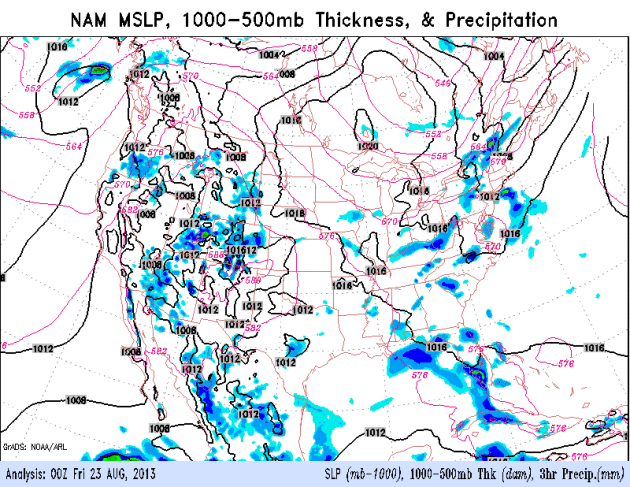

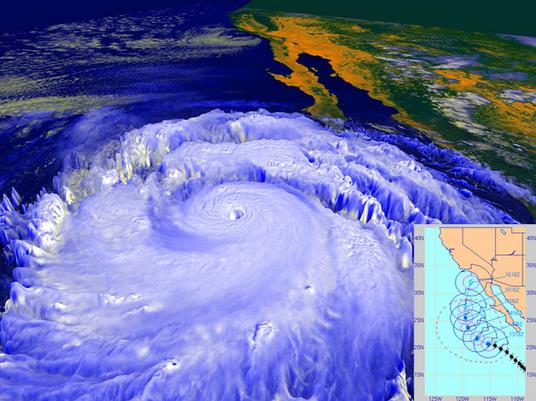

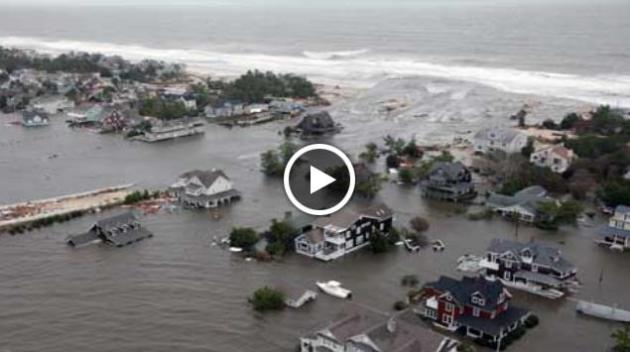
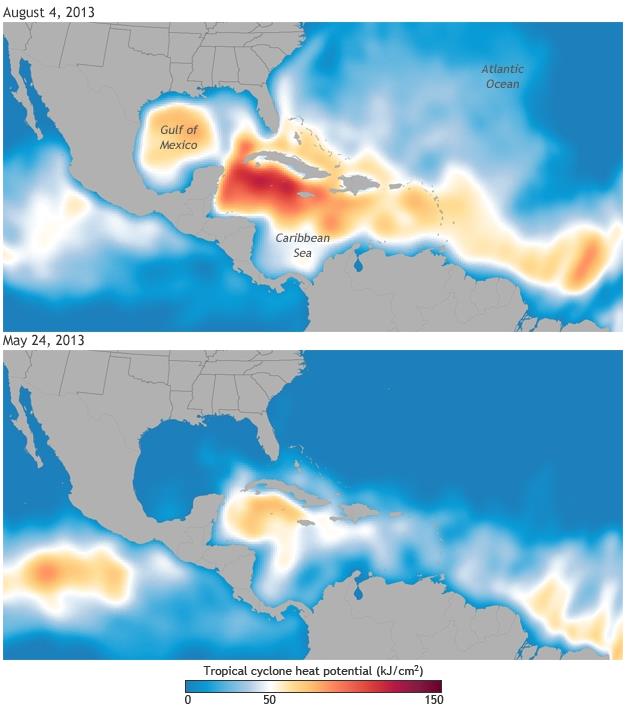


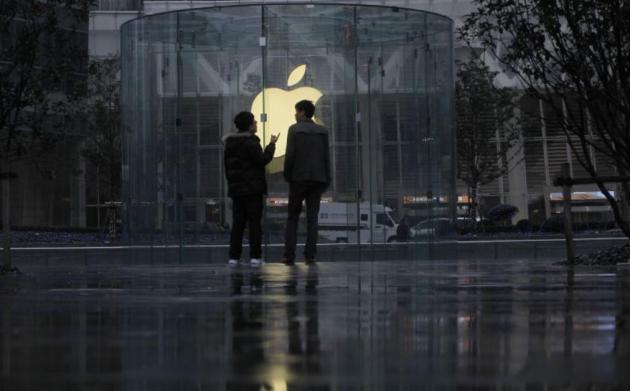








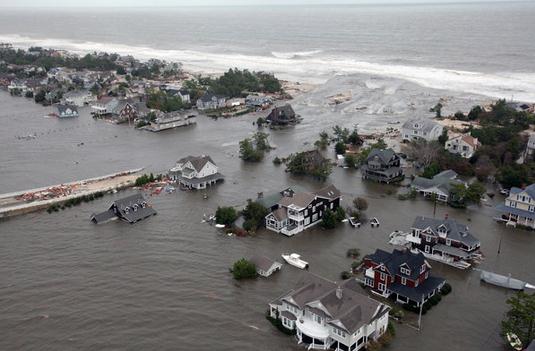
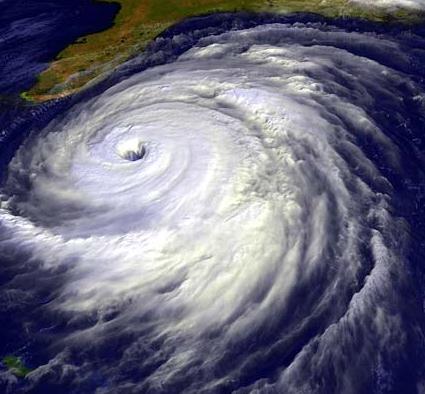


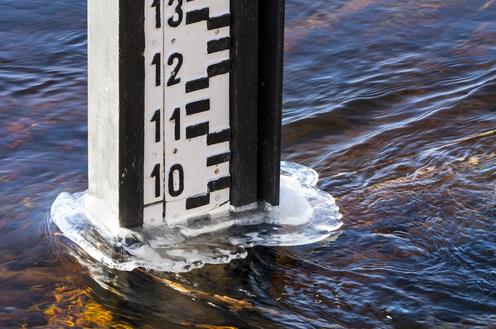
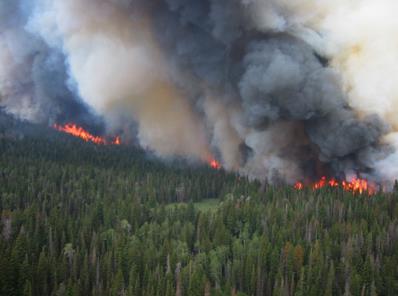
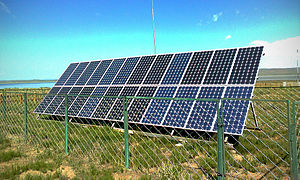

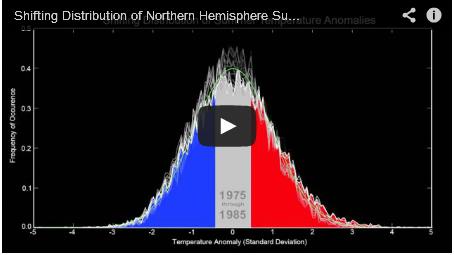
No comments:
Post a Comment